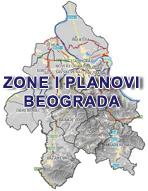PIONIRSKI PARK
One of the most beautiful parks in Belgrade. located between the Bulevar kralja Aleksandra, Kralja Milana, Kneza Miloša and Dragoslava Jovanovića streets. Until 1944 it has been surrounded with a high wall and served as a garden of the Old Palace (now the City Assembly of Belgrade). After removal of the wall, the park was put into public use and named Pionirski park, after the organization of the youngest (pioneers). In honour of the great writer of Yugoslav literature and Nobel laureate Ivo Andrić, a promenade named Andrićev Venac was built between the park and Kralja Milana Street, and a monument was raised up.
TAŠMAJDAN
Between Takovska, Ilije Garašanina, Beogradska streets and Bulevar Kralja Aleksandra, there used to be a large stone-pit. That is how this park has got his name Tašmajdan (in Turkish: taš - stone, majdan - pit). According to an old testimony "it may be freely said that all of the old buildings in Belgrade.... have been built of stone excavated here". In the catacombs left after the excavations of stone blocks, arsenals and military warehouses have been located for a long time, and these catacombs have been also used as shelters and first-aid places for wounded soldiers. During the siege of Belgrade in 1806, Karađorđe set a camp and pitched his tent here. After the Second Serbian Insurrection, Knez Miloš Obrenović started to build a Serbian town district in Savamala and about 1826 ordered that the old Serbian cemetery be moved from Varoš-kapija to Tašmajdan. At the plateau of Tašmajdan, the old St. Mark's Church was built in 1835 (destroyed in the bombing of Belgrade on April 6, 1941). On November 30, 1830, at Tašmajdan, the Sultan's hatišerif (charter) on the internal independence of Serbia was read. In 1909, the first Seismological Station was built, and it still exists today. At Tašmajdan and around it, there are today the St. Mark's Church (the new one, built in 1931-1936), the Russian Church (1924), the Main Post Office (1934), the Sport Center "Tašmajdan", the"Taš" and "Metropol Palace" hotels, the "Madera" restaurant, Radio-Television of Serbia, children's amusement park...
UNIVERZITETSKI PARK
It is located at the very center, in the old core of the city. The older citizens know it as Pančićev Park. In the Turkish time, there has been their graveyard, removed in the middle XIX century. Then the largest and most famous market has been made on one part of today's park (it was not removed until the thirties of the XX century). The first urbanist of Belgrade, Emilijan Josimović, had in mind something more "aesthetic" than a market, so after 1869, when the regulatory works began, he made the Great Market half shorter, and turned the remaining part into a park. The park got first urban outlines at the end of the XIX century, when the monument dedicated to Josif Pančić was placed there, and it was finally shaped in the thirties of the XX century, when the monument to Dositej Obradović was transferred from Kalemegdan and when today's baroque fence was made.
KARAĐORĐEV PARK
It spreads between Bulevar oslobođenja and Nebojšina Street. At this place was one of the camps of the insurrectionist army, during the attack on Belgrade in 1806. After the conquest of Belgrade, all killed insurrectionists were buried here. Knez Aleksandar Karađorđević raised a monument here in 1848, with an inscription: "In the glory and honour of the Serb heroes who bravely died for their fatherland in 1806, we raise this monument here". It is, at the same time, the first public monument raised up in Belgrade. The park started to form after the erection of the monument, and it was considerably expanded in 1903 and 1904. Just before World War II, a shelter was built in the park, in which 192 innocent citizens were killed during the German bombing on April 6, 1941. The stone slab at this place stands in memory of that tragic event. A few other monuments have been raised up in this park.
GRADSKI PARK IN ZEMUN
This is the oldest green oasis and Zemun's promenade. It was made in 1880 as the Mali Park (Small Park), on the place of former "kontumac" of 1730 (a sort of customs and quarantine station). By further planting in 1886 and 1888 it became the Gradski (City) Park. The buildings built in style of that time are preserved, like the building of the formerHigh School (finished in 1880, and extended in 1916). The oldest preserved monuments are part of the kontumac wall and two (restored) kontumac churches: the Orthodox Church of St. Gabriel the Archangel (of 1786) and Roman Catholic Church of St. Rocco (of 1836). Between those two churches is a column dedicated to A. Lamartine. It was raised by the Yugoslavia-France Society for the 100th anniversary of the time the great poet stayed in kontumac (quarantine). Two memorials remind of the more recent history, of the People's Liberation War. They have been made by the sculptors Vanja Radauš and Boris Kalina. Near the complex of the park is the Sports Center "Pinki - Zemun", built in 1974. |




Коментари
Постави коментар
Ovde možete ostaviti vaš komentar i sugestije